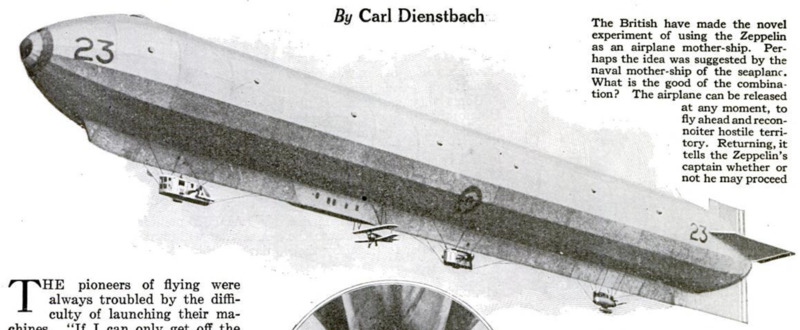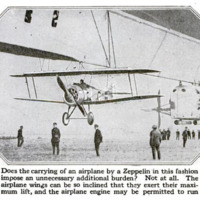Mothering the Airplane with the Zeppelin. How the British launch airplanes from their giant dirigibles
Contenuto
-
Titolo
-
Mothering the Airplane with the Zeppelin. How the British launch airplanes from their giant dirigibles
-
Article Title and/or Image Caption
-
Mothering the Airplane with the Zeppelin. How the British launch airplanes from their giant dirigibles
-
extracted text
-
THE pioneers of flying were
always troubled by the diffi-
culty of launching their ma-
chines. “If I can only get off the
ground,” each one of them said to
himself, “I will fly.” Dozens of
machines were wrecked before the
trick was learned.
Now, the Zeppelin dirigible had
been brought to virtual perfection
somewhat before the pioneers of
flying had fully solved the problem
of launching. Why not launch a
flying-machine from a Zeppelin?
The suggestion was made over and
over again. It seemed easy to start
the airplane from a speeding rigid
dirigible, for the wings would re-
ceive both the speed and the sup-
port that they need, with no inter
ference from wind-gusts.
The non-rigid type of dirigible
would hardly have lent itself to the
purpose; it could not Lift enough.
But the plan was well worth trying
with a Zeppelin traveling very low over a flying-field.
Probably the test was never made, because the art of
handling a Zeppelin in the air was acquired only with diffi-
culty after years of experi- |
ment. The early Zeppelin
navigators had troubles
enough of their own with-
out risking lives in launch- |
ing a flying-machine. |
With the modern Zep- |
pelin and the modern air- |
plane the result of such an
experiment isa foregone con-
clusion. An airplane could
be dropped even from a |
captive balloon at this late
day, and the balloon would
hardly be endangered by the
sudden release of so much
weight. Have not the fight-
ing flyers shown that they
can control their machines |
when they are dropping tail |
first, or slipping down side- |
wise, or looping the loop?
‘What would be the good |
of the proceeding? Would the air-
plane serve as a kind of life-boat?
Hardly. It could not carry enough
weight. On the other hand, a small
airplane would haveitsuses. ~Piloted
by an “ace,” it might give battle
to an attacking airplane or carry
out a reconnaissance over hostile
territory.
This idea of using the giant rigid
dirigible in connection with an air-
plane has been practically tested by
the British. No doubt the British
experiences with naval mother-ships
for seaplanes suggested the pos-
sibility of converting the Zeppelin
into a similar craft. Considered as
a mother-ship, a Zeppelin becomes
a formidable fighter and a most effi-
cient scout. Use the Zeppelin as a
‘mother-ship, and the advantages of
airplane and rigid dirigible are perfectly combined.
Not only can the airplane leave the Zeppelin in full flight
at any instant, but it ean return just us easily. The dirigible
has but to run at top speed
and the plane at its low
speed. The two vessels
leisurely come together.
Bl(riot hooked his moving
plane even to a stationary
wire years ago. Lieutenant
Locklear has shown how
easy it is to leap from one
plane to another.
The more we consider
the possibilities of the Zep-
pelin as a mother-ship, the
more we wonder why the
Germans did not carry out
the idea. It remained for
the British to reveal its
possibilities. The Germans
might have made similar
experiments for the last ten
years; but apparently they
lacked the imagination that
‘was necessary.
-
Autore secondario
-
Carl Dienstbach (writer)
-
Lingua
-
eng
-
Data di rilascio
-
1919-09
-
pagine
-
39
-
Diritti
-
Public domain (Google digitized)
-
Archived by
-
Davide Donà
-
Alberto Bordignon (Supervisor)





